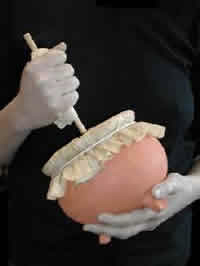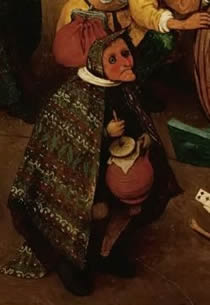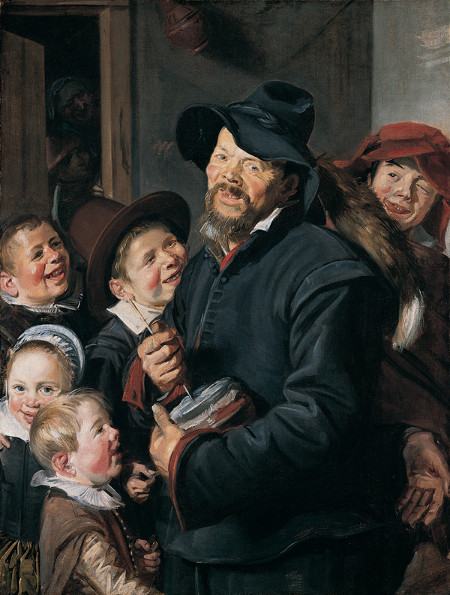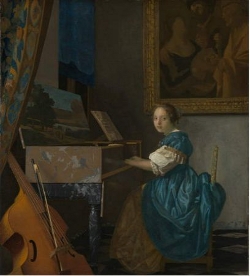Traditions of the Rommelpot in Flemish/Dutch Iconography
Although mainly seen as a children's instrument, the rommelpot was originally an adult's instrument, dating back at least to the sixteenth century. One of the first depictions of the rommelpot, also known by various other names in different regions, such as "rummelpot," "rumpelkiste," "bukszal," and "brummtop," appears in Pieter Brueghel the Elder's comprehensive Battle of Carnival and Lent (fig. 1) juxtaposing feasting on Shrove Tuesday, or Pancake Day, before Ash Wednesday and fasting from the following Ash Wednesday on for forty days until Easter.To the various names of the rommelpot in Belgium see Ferd J. de Hen, "Folk Instruments of Belgium: Part I," The Galpin Society Journal 25 (July 1972), 105.
In one of the scenes to the left-hand side of the composition, Shrove Tuesday, symbolized by Prince Carnival, is sitting on a large beer-barrel. Prince Carnival holds a pig's head on a spit as his weapon and a large pie on his headgear as a reserve for the coming time of hunger. A figure near the barrel, wrapped in a black-patterned cape plays a reddish rommelpot, a typical Carnival instrument with its "foolish" sound. The figure appears to accompany a fool's bell-ringing.To the social aspects of Brueghels Battle of Carnival and Lent and the religious controversies in post-reformatory Netherlands concerning discipline in faith see the comments by Roger Homan, Professor of Religious Studies at the University of Brighton, in: The Social Affairs Unit, Since the Middle Ages little shells have been a principal sign of the fool.
 fig. 1 The Battle of Carnival and Lent
fig. 1 The Battle of Carnival and LentPieter Brueghel the Elder
1559
Oil on wood, 121.3 x 171.5 cm.
Kunsthistorisches Museum, Vienna
After Brueghel's death his son Pieter (the Younger) made a fine copy of this painting, emphazising the encyclopedic aspect of the contents. It is housed in the Museum of Fine Arts, Brussels.


Pieter Brueghel
Oil on wood, 121.3 x 171.5 cm.
Musées Royaux des Beaux-Arts, Brussels
Detail with the figure playing the rommelpot in the foreground, accompanying the procession of the barrel with Prince Carneval and the foolish person ringing two little bells.
The rommelpot's history can be traced back to medieval and early modern Europe. It was a simple and inexpensive instrument that could be made with readily available materials, making it accessible to a wide range of people.
The rommelpot is typically made of a wooden container, often cylindrical or box-shaped, with a membrane or drumhead stretched over one end. The drumhead is usually made of animal skin or a membrane made from materials like parchment or leather. The open end of the container is equipped with a handle or a stick.
To produce sound with the rommelpot, the player would rub a wet hand or a cloth along the membrane while rotating the stick or handle rapidly. The friction created between the hand or cloth and the membrane produces a buzzing or droning sound. The wetness on the hand or cloth is essential for creating the friction necessary to produce the sound. The rommelpot produces a unique and resonant sound characterized by a buzzing or rumbling quality. The pitch and timbre of the sound can vary depending on the size and materials used in the construction of the instrument.
The rommelpot was often chosen by beggars who lacked appreciable skills since it was so easy to play. They either accompanied their own singing or provided the rhythmic grounds to the play of other fellow-musicians. Frans Hals set the roving rommelpot-player an everlasting monument with a renowned painting (fig. 2), of which a good seven variations are known today (Seymour Slive, catalogue 1974). He may have made two versions of the picture, one with five children and another with six, all cheerful listening to the smiling beggar's music-making and story-telling.To the extended version with 6 children Seymour Slive (catalogue 1974 to the complete work of Frans Hals) had counted a half dozen of copies still existing today (Slive 1974, L 3). See also Seymour Slive, ed., Frans Hals, exh. cat., National Gallery of Art, Washington D.C.; Royal Academy of Arts, London; Frans-Hals-Museum, Haarlem, 1989/90, London, München 1989 (German ed.), 148–151. Since Hals had ten children of his own, some of them may have modeled for the boys and girls.

Frans Hals
c. 1618–1622.
Kimbell Art Museum, Forth Worth
The large fox tail at the beggar's hat as well as the striking red baret of the boy to the right side both things attributes of the fool point again to the playing of the rommelpot in the time of Carnival, although there were other times, too, for wearing grotesque headgear and playing the rommelpot (see below Jan Steen, The Bean Feast).
Hals' treatment of the theme was pioneering for his time. Never before had the merriment of children and a beggar (beggars were traditionally represented in dismal circumstances and in bad humor) been the unique focus of a painting with all the figures shoved to the foreground. Hals' novel interpretation inspired numerous copies (fig. 3) made both in and outside his own workshop. These copies have caused problems of attribution to art historians. Even after the thorough restoration of the so-called "Kimbell-version" in 1988, Frans Hals scholars are still in disagreement as to its authenticity.Seymour Slive, ed., Frans Hals, exh. cat., National Gallery of Art, Washington D.C.; Royal Academy of Arts, London; Frans-Hals-Museum, Haarlem, 1989/90, London, München 1989 (German ed.), 151. The original version with five children is probably lost. A lovely contemporary version of Hals' composition comes from his best pupil Judith Leyster My apologies for the previous responses. Here is the correct formatting according to your instructions:
(1609–1660) (fig. 4) who married the successful genre painter Jan Miense Molenaer. Her version may have been originated in the 1630s.Seymour Slive, ed., Frans Hals, exh. cat., National Gallery of Art, Washington D.C.; Royal Academy of Arts, London; Frans-Hals-Museum, Haarlem, 1989/90, London, München 1989 (German ed.), 151.


Judith Leyster
c. 1630
Oil on panel, 39.1 x 30.5 cm.
Chicago, The Art Institut of Chicago
Jan Steen
1660–1662
Oil on panel, 32.8 x 26.1 cm.
City Art Gallery,
Manchester
Another Dutch painter who depicted the subject at least twice was Jan Steen (c. 1626–1679). During his stay in Haarlem 1661–1670 he may have seen one of the numerous copies of Hals' work inspiring his own version, a genre interior with three figures. Like many other of his genre paintings, Steen portrayed himself, here as the rommelpot player, accompanied by his wife Margriet"Grietje," daughter of the landscape painter Jan van Goyen. on the recorder while a third, obscure person in the background raises a glass (fig. 5). But contrary to Hals' innocent group of cheerful children surrounding an elderly musician, Steen's depiction is owerflowing with jocular eroticism.
In his popular Twelfth Night (fig. 6) Steen again takes up the motif of the fool playing the rommelpot derived from the Brueghel-painting.
In the seventeenth century, Twelfth Night"Twelfth Night" is a traditional holiday celebrated on January 5th, marking the end of the Christmas season and the eve of the Epiphany on January 6th. It is historically known for festive celebrations, including the baking of a special Twelfth Night cake, which often had a bean or figurine hidden inside. The finder of this item would be crowned the King or Queen of the festivities. The holiday is also famously associated with William Shakespeare's play "Twelfth Night," reflecting themes of revelry typical of the day. Traditions like wassailing were common, especially in apple-growing regions. While the celebration of Twelfth Night has declined over time, it has seen revivals in some areas as part of cultural preservation efforts. Today, where celebrated, it often includes parties, singing, and the taking down of Christmas decorations. (Driekoningen), which marks the end of Christmastide"Christmastide", also known as the Christmas season or the Twelve Days of Christmas, is a festive period in the Christian calendar that begins on Christmas Day (December 25th) and ends on the Epiphany (January 6th). It encompasses various religious and cultural celebrations, including church services, gift-giving, and festive meals. This period includes specific feast days like Saint Stephen's Day and the Feast of the Holy Innocents. Traditionally, it i a time for continued Christmas celebrations, singing carols, and displaying decorations and Nativity scenes. In many Western Christian churches, white or gold are the liturgical colors used during Christmastide, symbolizing joy and celebration. The period often concludes with Twelfth Night, after which Christmas decorations are traditionally taken down. Christmastide thus represents both a continuation of the Christmas celebration and a reflective time leading up to the Epiphany. (see Midwinterhoorn), was an occasion for celebrate with family and friends. The person who found a bean in his cake during the gathering was elected "king." The highlight of the event was the king's first draught, taken to the call "De Koning drinkt!" In Steen's Twelfth Night The toast "De Koning drinkt" ("The King drinks") may be derived from a Flemish Cantio Natalitia (Christmas carol) from the sixteenth century, "Haest uw o herderkens," which tells from the three Magi ("Wise Men") who, after a long journey, have found the new-born Jesus with his mother Mary in a poor stable in Bethlehem. As they become witness of Mary's feeding her baby they call with great joy: "Den Coninck drinckt!." See CD Cantiones Natalitiae, performed by Camerata Trajectina, 1995. This call is also to be found in traditional songs for the Driekoningenfeest (Twelfth Night), like the popular "Drie Koningen Vreught" ("Three Kings' Joy"), where the refrain goes: "Vive la den Koningh drinckt." See CD De Muzikale Wereld van Jan Steen (1626–1679) / The Musical World of Jan Steen, performed by Camerata Trajectina, 1996. (See also "Suggested listening" at the end of section 1: Music and Dance"). the young boy who has become the king, proudly wears his paper crown and takes his first sip of alcohol under the eyes of his tipsy mother. A woman dressed as a Beguine nun, most likely the lad's grandmother, assists the scene in silence. Steen portrays himself as low-life figure singing away while seated at the table. His wife Grietje smiles at the fool as a priest (see detail below right) serves to remind the distracted viewer that the Twelfth Night was indeed a Catholic feast. In predominantly Protestant Holland, this holiday was resolutely disapproved by Calvinistic clergy as it frequently ended in riotous carousals, so well known from Steen's paintings. Steen's paintings were popular despite the censure.

Jan Steen
1668
Oil on canvas, 80 x 105 cm.
Staatliche Museen, Kassel
The man standing to the right has taken the role of the fool, which is indicated by a small note at his fancy hat, just playing the rommelpot. In the background to the right the 'priest' is visible, his role also indicated by a note at his black hat.

Jan Miense Molenaer
1629
National Gallery London
Click here for period rommelpot music:
The popular rommelpot-song
'Ick heb zo lang met de foekepot gelopen', sung by children at Kloetinge (Zeeland).
from:
Folksongs and Dances of the Netherlands. Collected and notes by Wilhelmina D. Scheepers. 1968.
Text of the refrain:
Ik heb zo lang met de foekepot gelopen
'k Heb geen geld, om brood te kopen
Foekepotterij, foekepotterij
Geef mij een oortje, dan ga ik voorbij
(I have run so far with the rommelpot and still no money to buy bread. Rommelpottery, Rommelpottery, Give me a penny and I'll be off.)
In Jan Miense Molenaer's cheerful Two Boys and a Girl Making Music (fig. 7) the rommelpot is at last represented as a children's instrument. A young boy plays a violin while the girl at the center of the picture wears a soldier's gorget and beats a pair of spoons on a helmet. The boy clad in red, evidently quite proud with his mansion, keeps the rhythm with his home-made rommelpot. The three children clearly belong to the lower class. Molenaer, whose work displays an enormous range of motifs, specialized in low-life genre scenes throughout his career.
One of the great popular traditions of the Netherlands dates back to the Middle Ages. On evening of Twelfth Night, groups of three children dressed up as the Three Kings went from door to door singing a sterrenlied and asking for a bit of money. In earlier times this procession usually took place with pupils from a convent school, guided by a priest. See Marita Kruijswijk, Marian Nesse, Nederlandse jaarfeesten en hun liederen door de eeuwen heen. Hilversum 2004. 42: Sterrenzangers. The collected money from the early "supervised" processions had certainly been used by the Catholic Church for the many clerical almshouses. After the 'supervision' had ceased the children were allowed to keep the money for themselves res their families. That's also why the custom of giving money changed here and there in favor of fruits or sweets, which the children could really keep for themselves. Unfortunately, in the course of the eighteenth and nineteenth century the sterrenzangers were more and more held as bothering beggars, and the Driekoningen-procession vanished in several areas. By the seventeenth century this custom had more and more been adopted by children of the lower class who must have accompanied their joyous revelry with the rommelpot (see also expert-box Fred J. de Hen).
On Oudejaarsavond (New Year's Eve) or Saint Maarten (11th November) Dutch children went from house to house singing rommelpot-songs asking a few coins or sweets. Beforehand, they had no doubt eagerly built their rommelpots, each one trying to make "best" one that would make the most bizarre sound.
After the two tragic wars and the gradual urbanization of the Netherlands, many of traditional rites began to disappear, however, rommelpot-songs have resisted and are still quite popular among today's children. The rommelpot remains a popular instrument among many of the Dutch folk-groups to accompany many rustic boerenliederen (peasants' songs).
Music in Vermeer's Life: Conclusion

Jan Steen
1668
Rijksmuseum Amsterdam
Steen depicted his own family cheerfully engaged in making noisy music. Four musical instruments are to be viewed in the painting: the bagpipe, the fiddle, the transverse flute and a horn.
When Vermeer was a boy, he must have taken part in the endless cycle of public feasts and processions and years later. After he had grown up, married and moved with his family to his mother-in-law's house in the "Papenhoek" at Oude Langendijk, children knocked his door as he had done before, singing their little songs to earn a favor.
Vermeer knew the songs and dances which were accompanied by music of the fiddle, bagpipe, hurdy-gurdy or shawm and the other popular instruments. We know that he was raised in his father's inn Mechelen right in the center of Delft on the Market Square where most of the festivities took place. Music must have been all around. The rustic low-life scenes staged in inns and taverns, peasants' traditional festivities or private "merry" gatherings of the great Dutch/Flemish genre masters, like Adriaen van Ostade, Adriaen Brouwer, David Tenier, were familiar to all.
But Vermeer took a different route (fig. 8), one more artistically noble and potentially lucrative, one that brought him into contact with the refined and sophisticated daily life activities of the upper class. From his relatively humble origins, the courting Vermeer may have gained personal access to the upper crust of society through the patrician connections of his mother-in-law Maria Thins, through his patron Pieter van Ruijven (1624–1674), one of the wealthiest burghers in Delft, or perhaps, through his official post as Dean of the Guild of Saint Luke, to which he was elected twice.
This artistic decision was his own personal one, and his paintings, unsurpassed in their art, are the unequivocal evidence that he was right. As we know, music-making took considerable part in his oeuvre. The comparison below with a work by Vermeer's colleague Jan Steen (fig. 9) may prove instructive.

Johannes Vermeer
c. 1670–1675
Oil on canvas, 51.5 x 45.5 cm.
National Gallery, London
Vermeer depicted an ideal harmonious combination of two "classical" instruments: the viola da gamba (though never actively be played in Vermeer's oeuvre) with its human-like sound, together with the soft-toned virginal, here symbolizing the harmony of two hearts in love.

and to the right the singer (although usually the three children
sang all together).
The traditional use of the friction drum (rommelpot)
Ferd J. de Hen
"As a rule the friction drum was (and in some villages still is) played with the so-called 'sterre-liederen' (Songs of the Three Kings during which a star fixed on a stake is carried round, hence the name 'star-songs' about Christmas, New Year and Epiphany, anyhow always after All Saints. (In Flanders pigs were killed during the month of November). Originally there were three men: one to carry the star, who was at the same time the singer; one lantern bearer; and the player of the friction drum. They represented the Three Wise Kings of the Orient, and were made up with the three ritual colours, for which they used soot, blood and flour, with the symbolic meanings: black, death; red, expiatory offerings; white, life. (Originally the pig's blood was used to dye the hands and face.)
Near Nederokkerzeel, there were three fixed periods when the instrument was used: (a) Christmas – New Year's Eve – New Year – Epiphany, (b) Shrove Tuesday, (c) Maunday Thursday (this also in Flanders). At these times there are always pig-bladders at hand since slaughtering took place (and even nowadays in some villages) at the following dates: (a) from a month after the 'alaut' (the harvest of potatoes), thus from the end of October and especially between the 15th November and the 15th December; this period is also called 'baumestijd' (the time of Saint Bavo), (b) one to three weeks before Shrove Tuesday they feast and drink well. All the tar-feasts of the guilds, fanfares and other societies take place in this period. (c) the period of the 'uitkom' (lit. the 'out-come', meaning spring), on to three weeks preceding Holy Week. The meat must anyhow be removed from the salt before the first hot weather. The bladders for use on these various occasions were hung to dry for one or two weeks.
The rommelpot used to be played almost everywhere in Flanders but had already disappeared in most regions before the first world war and was replaced by the accordeon. Till 1937 the rommelpot was played in Roeselare, in the Voerstreek, Leefdael, Bertem [and others], in Westmalle till after 1945. In Wakken (East Flanders), a singer with the rommelpot wandered around still in 1954, and in Berendrecht, Zandvliet and Dendermonde even in 1958."
from: Ferd J. de Hen, "Folk Instruments of Belgium: Part I," The Galpin Society Journal 25 (July 1972). 105–110.
Both masters depicted a considerable variety of musical instruments in Dutch seventeenth-century art, and the remarkable proportion of music-making in their respective œuvres is of nearly the same percentage. Although their personalities and artistic styles are so contrasting, they shared the same fondness of music. In his introduction to the CD De Muzikale Wereld van Jan Steen (1626–1679) / The Musical World of Jan Steen (see note 8) musicologist and master-musician Louis Pieter Grijp wrote:
"The musical world of Jan Steen is finally completely different from that of painters such as Johannes Vermeer or Pieter de Hooch: not only is it more rowdy and more multifaceted, but also more personal and more specific. This can be explained on the one hand by Steen's intentional focus on popular culture, and on the other by the inspiration that he drew from literary and musical humour. It is through these factors that this music is able to teach us something about Jan Steen himself as well as about the culture of which he was part."
And this "popular culture" was exactly the same Vermeer had grown up and was in constant touch with throughout his entire, but short life.
Adelheid Rech
June 2008
Rommelpot resources:
- Oxford Music Online (former Grove Music Online):
article "Friction drums" (Drums, §1,4): Anthony King, Mervyn McLean, Mary Riemer-Weller, Robert Anderson. - Ferd J. de Hen, "Folk Instruments of Belgium: Part I." The Galpin Society Journal 25 (July 1972). 105–110.
- Seymour Slive, Frans Hals. exh. cat. National Gallery of Art, Washington D.C.; Royal Academy of Arts, London; Frans-Hals-Museum, Haarlem 1989/90. London, München 1989 (German ed.).
- Peter Suiton: review "Frans Hals. Washington and London." The Burlington Magazine 132, no. 1042
(January 1990) 67–70. - Wikipedia-Netherlands:
rommelpot
http://nl.wikipedia.org/wiki/Rommelpot_%28muziekinstrument%29